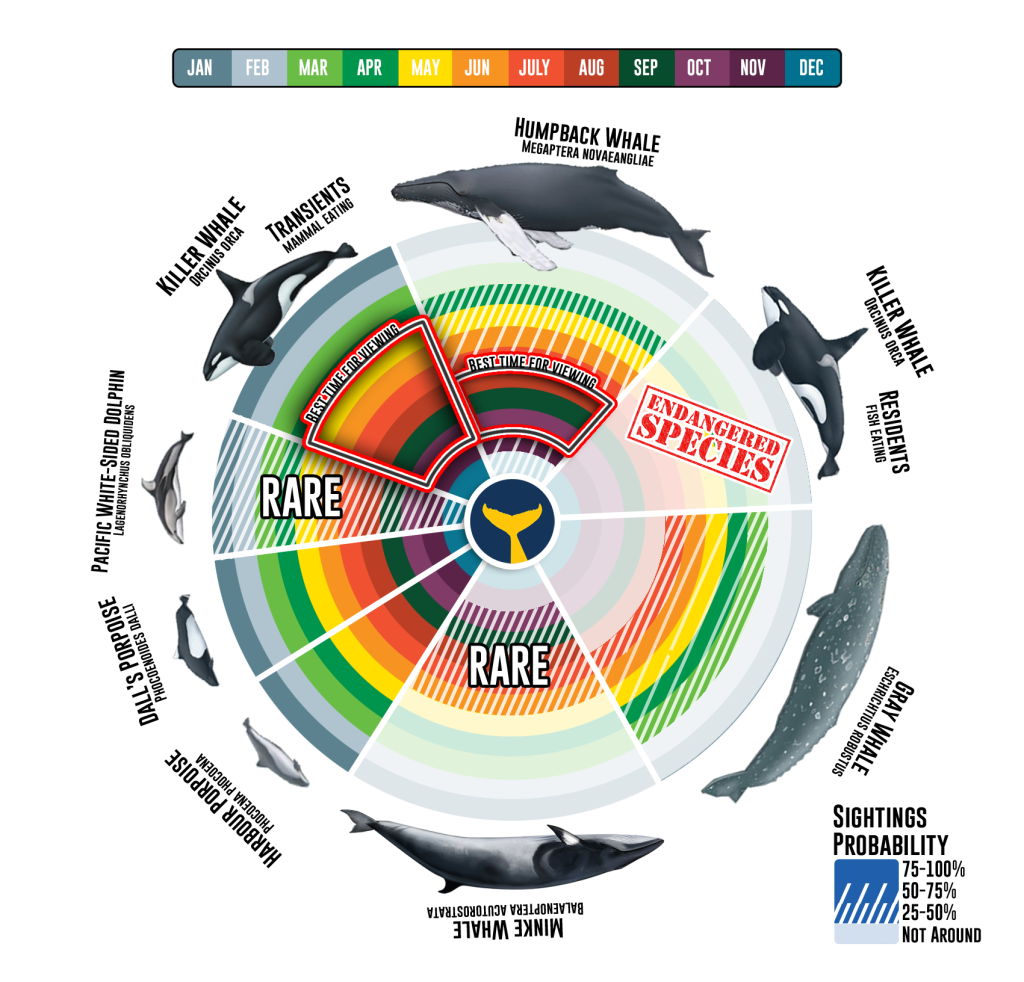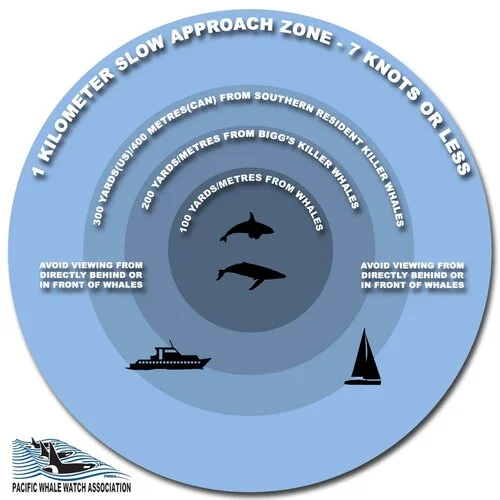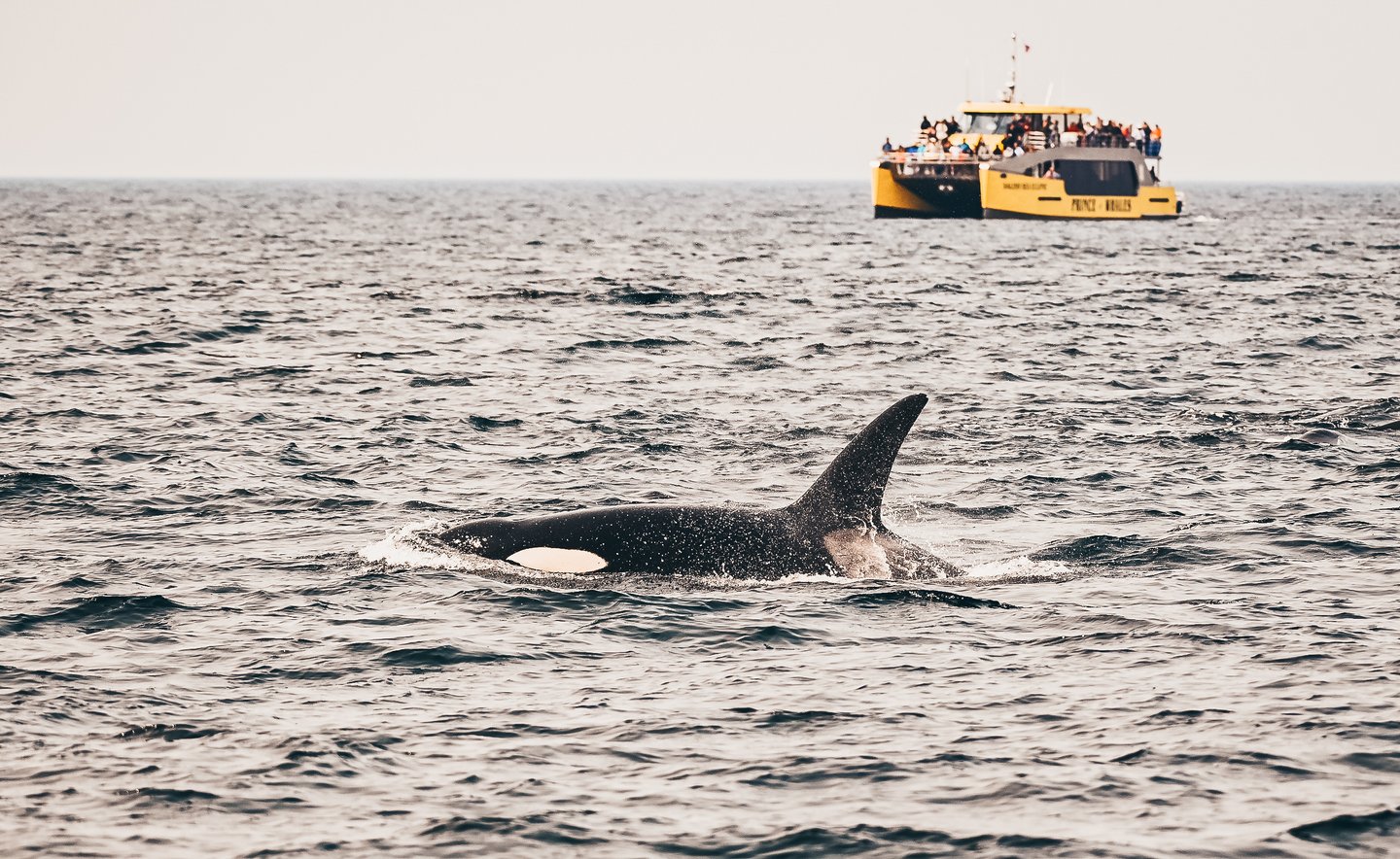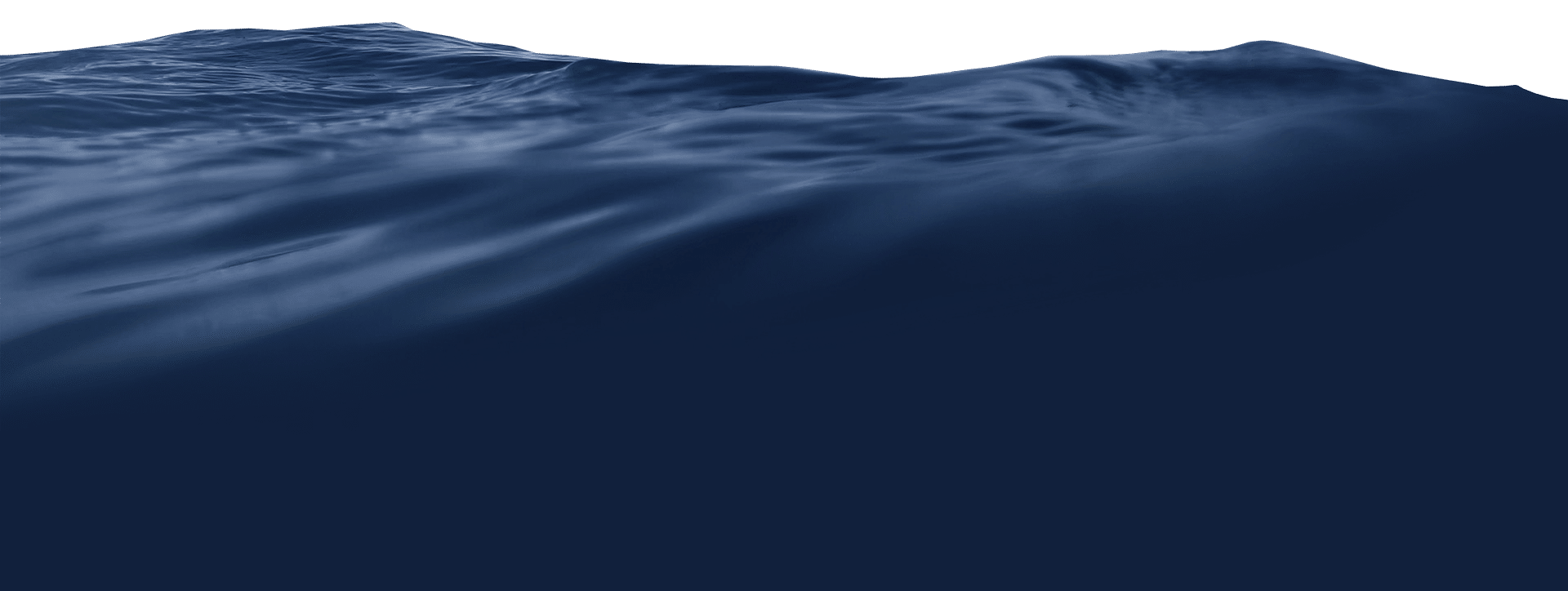Victoria whale watching season
Best Time to Go Whale Watching in Victoria
The question we’re most frequently asked, and one that undoubtedly piques everyone’s curiosity, is “What is the best time for whale watching in Victoria?”. The ideal time for your adventure hinges on the species you’re keen to observe and your adaptability to unpredictable weather conditions. The waters near Vancouver Island create a thriving ecosystem for an astonishing array of marine wildlife, earning a global reputation as a premier destination for the region’s best whale watching tours. Our waters are the natural habitat to the majestic presence of Killer Whales (Orcas), Humpback Whales, Minke Whales, and Gray Whales, as well as playful porpoises, seals, sea lions, and otters. The region is also home to bald eagles and a diverse assortment of pelagic (ocean-going) birds that grace the skies above.
Throughout the year, our whale watching tours provide the opportunity to marvel at Transient Killer Whales’ regular visits to the Salish Sea. In contrast, Humpback Whales frequent the narrow passages primarily during the summer and fall seasons. Gray Whales make a rarer appearance in the spring and summer, while elusive Minke Whales share the same seasonal preference as Humpback Whales. For a Victoria whale watching trip that features both Killer Whales and Humpback Whales in abundance, we recommend planning your tour between July and November. However, with a 95% whale sighting success rate, our tours offer a high probability of witnessing these magnificent creatures regardless of the season.

Whales by Month In Victoria
We’ve designed an informative whale pinwheel chart that visually represents the prevalence of various marine mammals throughout the year. In addition to the species featured on our chart, you can frequently spot sea otters, sea lions, bald eagles, and seals during your whale watching adventure.
Best Time of Day to See Whales in Victoria
There isn’t a definitive “best time” for whale watching, as it can be influenced by factors such as the season, weather, and the marine mammals you were hoping to see. During the whale watching peak season, we offer a range of tours, from early morning departures to sunset trips in the late afternoon. Each whale watching excursion has its own unique atmosphere, guided by our knowledgeable experts who seek out memorable Killer Whale and Humpback Whale sightings.
Our whale watching tours leaving in the early morning can expect the waters to be calmer, and the cooler temperatures encourage whales to surface more frequently to breathe. Additionally, the soft lighting of the early morning sun enhances the Orca whale watching tour viewing experience, casting a magical glow over these majestic creatures as they break the surface. Much like the early morning, during a sunset whale watching tour the ocean often becomes tranquil, and the cooler temperatures of the evening entice whales to surface more frequently to breathe. The enchanting hues of the setting sun are the perfect backdrop to watch breaching Humpback and Killer Whales.
Since there are so many factors that affect the time of day to see whales, we generally recommend that guests pick a time that best fits their schedule. Our Victoria whale watching tours have over a 95% sightings rate, so there really is no bad time!
Whale Watching Tour Experience
How it Works
Get treated like royalty
You’ll enjoy talking with our crew because they care about your experience—they’re even SuperHost trained and certified for unparalleled service.
Leave the logistics to us
If you’re touring with us, chances are you’ve already planned a trip from another city, province, or country. We’ll simplify your whale watching adventure so you can take a break from logistics.
Take time to relax
Nothing like getting shuffled around on a whale watching tour. We schedule our whale watching tours so you can actually take in the sights and take time to relax—what a novel idea, we know!
Enjoy the entertainment
We’re an eclectic bunch, and we pride ourselves on delivering a unique experience with every tour.
Book online (or on the phone)
You can book you whale watching tour online with the click of a button (or two). Call us at 1-888-383-4884, and we’ll be excited to get you booked!
Read your confirmation email
We’ll email you a confirmation immediately after you book including all you whale watching tour details of your adventure, like what to bring and where to go.
Check-in at Prince of Whales
You’ll want to arrive at your designated check-in at least 30 minutes in advance to read and sign your waiver and contribute your $5 conservation fee benefitting 1% for the Planet.
Get ready AND get excited
This is not your average tour; it’s a seafaring adventure where you’ll cruise at high speeds while learning why we love our local Orcas and Humpback Whales like our very own family.
Expect a surprise or two
An adventure wouldn’t be an adventure without a surprise or two. From colouring books for our Junior Naturalists to post-adventure email debriefs, expect the unexpected.
Whale Watching Vancouver Guidelines

Operation of Vessels in the Vicinity of Whales
A vessel shall approach an area of known or suspected whale activity with extreme caution.
A vessel within 1 km or 0.65 miles of a whale is considered to be in the vicinity of whales and is required to abide by all of these Best Practices Guidelines.
If a vessel operator is unaware of the whales’ location, he/she must maintain a vigilant watch for whales at all times. Mere observation of whale watching vessels in the distance does not fulfill this responsibility, as individual whales may be encountered anywhere, at any time. Maintaining a vigilant watch often includes significant speed reductions.
A vessel within the vicinity of whales – within 1 km (0.65 miles) of a whale – is considered to be in the slow zone and must operate at no more than 7 knots (13km/h). This reduced speed zone shall also be observed when disengaging from the vicinity of whales as well.
A vessel shall approach an area of known or suspected whale activity with extreme caution.
- When whales are within 800m of the shore, vessels should maintain a seaward position and not within 200m of any shoreline that the whales are travelling along.
- All sonar, depth sounders, fish finders, and other underwater transducers should be shut off whenever a vessel is in the vicinity of whales.
Parallel Viewing Sequence
When approaching vessels already engaged in viewing a whale or group of whales, the vessel operator must ensure his vessel moves to the outside of the vessels already accompanying these whales, and head in a direction parallel to the direction these whales are travelling. This is meant to maintain existing view angles of all vessels previously on scene.
Vessels should maintain heading and speed equal to the whales at all times while paralleling.
Minimum approach distances should be maintained as follows; US: 200 yards from Killer Whales, 100 yards from all other whales. In Canada: Southern Resident Killer Whales shall not be viewed based on joint agreements and laws to protect this world-famous and endangered population. 200 meters from Bigg’s Killer Whales (with whale watching exemption), and 100 meters from all other whales. An additional buffer should be added, depending on the behaviour, especially when viewing at 100 meters.
A vessel’s speed should be the same as the whale’s speed or slower. However, when travelling slower than the speed of the whales, a vessel relinquishes its priority sequence. This technique is generally used to disengage the vicinity of whales when the intention is to break away and return to port. When leading a group of paralleling vessels engaged in viewing whales, that vessel should keep pace with whales so as to not block any vessels behind them. Furthermore, that vessel should not shut down without adequate notice to the vessels following behind.

